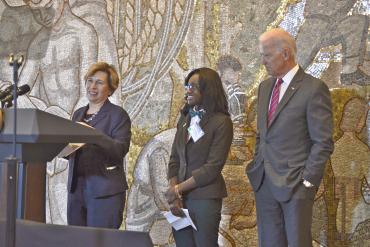The Promise of Career and Technical Education
On the surface, the latest jobs report from the Department of Labor is good news—an estimated 214,000 jobs were added in October, which translates into 54 months of job growth, the longest streak of uninterrupted private sector job growth in our nation’s history.
However, a deeper look at those numbers shows that while more Americans may be finding jobs, wages are standing still. As the Economic Policy Institute reports, earnings for the wealthy few have surged upward while paychecks for the vast majority of Americans have been falling behind.
And people feel it deeply. According to exit polls after the recent midterm election, 70 percent of voters said that their family’s financial situation has stayed the same or gotten worse over the last two years.
What this means is our nation’s ever-widening income gap is growing, and the promise of America—that idea that when you work hard, you get a decent shot—is slipping further out of reach for too many.
In those exit polls, voters also expressed frustration about the future for their families. Nearly half said they expect life for “future generations to be worse than life today,” and 78 percent said they’re worried about the future direction of the economy.
We know that Americans are hungry for good middle-class jobs that will move us toward a shared prosperity. And when the labor movement was strong, so was the middle class. We know we need to rebuild both—because Americans want to work, but in return they want a decent wage that will allow them to support themselves and their families.
This week, the AFL-CIO and our union teamed up to convene a summit on how to solve a piece of this. The summit attracted everyone from Vice President Joe Biden and Labor Secretary Thomas Perez to business and union leaders, as well as educators and students from high-quality career and technical education programs.
The aim of the summit was to help current workers, dislocated workers and young people get the skills they need to be prepared for the good jobs of today and tomorrow. The standing-room-only crowd discussed how to scale up and CTE programs that provide multiple pathways to high school graduation, higher education, advanced training and certification, and careers in everything from healthcare and robotics to aircraft maintenance and clean energy. And what everyone concluded is this is the promise of high-quality CTE.
As Vice President Biden said: “Unions have helped to build the middle class. Now we’ve got the job of rebuilding it. This is not about conflict, this is not about pitting business against labor. This is about getting the best-educated workforce in the world.”
Nicholas Pinchuk, chairman and CEO of Snap-on Tools, agreed, noting: “We are in a global competition for jobs; the single best weapon is CTE. We need to out-skill the competition.”
The overwhelming interest in this summit, just days after the election, shows that CTE is an approach that appeals to both Republicans and Democrats.
However, fulfilling the promise of CTE requires resources, partnerships, funding and real input from teachers. As we heard from 570 CTE educators in a recent AFT survey, teachers are excited about the success of CTE, and this success shows in statistics like these: For those with a CTE concentration, 9 in every 10 graduate on time and 7 in every 10 go on to enroll in postsecondary education. However, these educators also stressed that they need 21st-century technology and equipment in order to match what’s in today’s business settings.
And business leaders at the summit, such as Lorilyn Owens with the Oracle Academy, stressed the importance of listening to teachers. These business leaders believe in CTE because they are true partners in programs that work to give them the skilled workforce they need. At the same time, the businesses provide vital opportunities through internships, mentoring and a pipeline to employment.
Lily Mohamed, who graduated from Platt Technical High School in Connecticut and now works in avionics for Sikorsky Aircraft Corp., was mentored by a Teamsters union member who helped her learn not just the technical skills she needed, but how to excel in a professional environment. “I had the upper hand because I learned the skills I needed for my job in high school,” she said.
CTE programs around the country are giving students like Lily a viable path to the future. To scale and sustain these successes, Congress must act to reauthorize the Carl D. Perkins Career and Technical Education Act with full funding. The AFT is committed to ensuring that CTE educators and students get the resources they need; the time to connect with employers and the community; class sizes small enough to facilitate learning; and diverse program offerings to meet the needs of students and the labor market.
But we can’t do it alone. As we saw at this summit, policymakers, business, labor and community can come together to make CTE a thriving component of our 21st-century education system—and with it, an engine that helps more young people have access to good jobs and the American dream.

